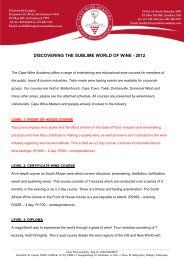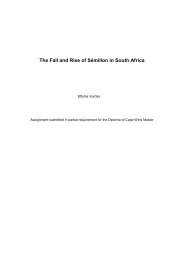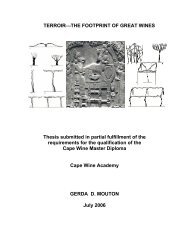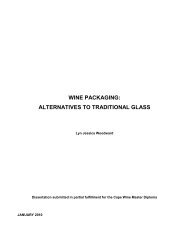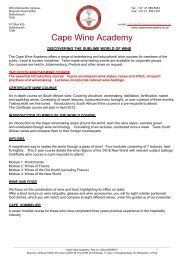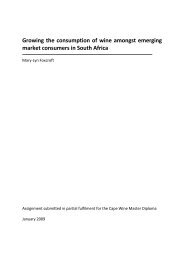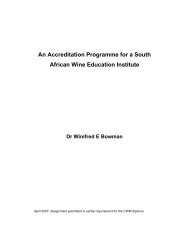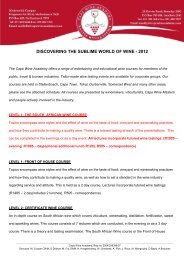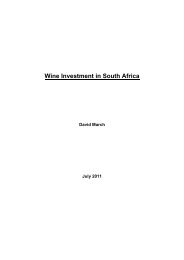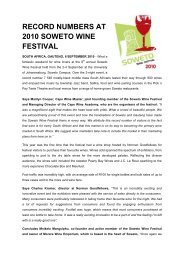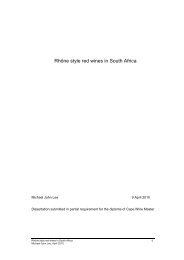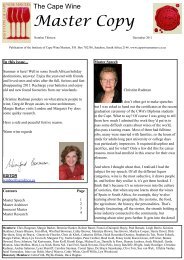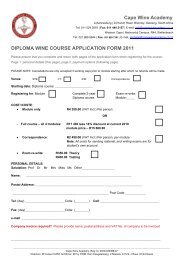micro-oxygenation in contemporary winemaking - Cape Wine ...
micro-oxygenation in contemporary winemaking - Cape Wine ...
micro-oxygenation in contemporary winemaking - Cape Wine ...
You also want an ePaper? Increase the reach of your titles
YUMPU automatically turns print PDFs into web optimized ePapers that Google loves.
Micro-<strong>oxygenation</strong> <strong>in</strong> Contemporary W<strong>in</strong>emak<strong>in</strong>gTable 14: Common Tests for the Analysis of Phenolic Compounds <strong>in</strong> W<strong>in</strong>eCategory Test Measurement Pr<strong>in</strong>ciplesTotal PhenolsAnthocyan<strong>in</strong>sTann<strong>in</strong>sW<strong>in</strong>e ColourFol<strong>in</strong>-CiocalteuTestOD 280[Anthocyan<strong>in</strong>]PVP IndexIonisation <strong>in</strong>dexHPLC[Tann<strong>in</strong>]LA MethodHPLCMDPHCl IndexDialysis IndexGelat<strong>in</strong> IndexColour IntensityColour StabilityHueColourCompositionMeasure total phenols by reaction of the hydroxyl groups with a phosphormolybdatereagent which can be measured spectrophotometrically.The benzene molecule characteristically absorbs at 280nm so the opticaldensity at 280nm is a simple measure of [total phenol]. Various corrections havebeen proposed to provide more accurate estimates.There is no simple test to measure [total anthocyan<strong>in</strong>]. Changes <strong>in</strong> OD520 afterHCl addition or SO2 bleach<strong>in</strong>g can be used to estimate [anthocyan<strong>in</strong>]. Both testsmeasure the sum of [free anthocyan<strong>in</strong>] + [bound anthocyan<strong>in</strong> susceptible tobleach<strong>in</strong>g].Measures the proportion of free anthocyan<strong>in</strong>s and anthocyan<strong>in</strong>s bound to tann<strong>in</strong>(T-A forms). Free anthocyan<strong>in</strong>s b<strong>in</strong>d to a PVP column whereas T-A forms donot.Measures the proportion of coloured and uncoloured anthocyan<strong>in</strong>s. Based onthe difference <strong>in</strong> effect of SO2 bleach<strong>in</strong>g on w<strong>in</strong>e colour at normal w<strong>in</strong>e pH andat a pH of 1.High performance liquid chromatography can be used to separate and quantifydifferent anthocyan<strong>in</strong> compounds.Under acid conditions tann<strong>in</strong>s can be hydrolysed to form coloured cyanid<strong>in</strong>s(tann<strong>in</strong>s are also termed procyanid<strong>in</strong>s). The change <strong>in</strong> colour after addition ofHCl is measured at OD550. Various corrections have been proposed to providemore accurate estimates.High performance liquid chromatography can be used to separate and quantifydifferent tann<strong>in</strong> compounds.The mean degree of polymerisation (MDP) <strong>in</strong>dicates the average cha<strong>in</strong> length ofthe polymeric tann<strong>in</strong>s. Measured by acid depolymerisation <strong>in</strong> the presence of anucleophilic agent such as toluene-α-thiol (thiolysis) to identify term<strong>in</strong>al units.Measures the proportion of large polymeric forms. Based on the hydrolysis oftann<strong>in</strong>s <strong>in</strong> an acid medium where speed of precipitation depends on degree ofpolymerisation. Values range from 5-40. HCl <strong>in</strong>dex > 25 <strong>in</strong>dicates highlypolymerised tann<strong>in</strong>s.Measures the proportion of tann<strong>in</strong>s that do not pass through a dialysismembrane under standard operat<strong>in</strong>g conditions. Depends on size and charge oftann<strong>in</strong> molecules. Values range from 5-30.Measures the reactivity of w<strong>in</strong>e tann<strong>in</strong>s with gelat<strong>in</strong>. Used as an <strong>in</strong>dication ofastr<strong>in</strong>gency. Values range from 25-80.Total amount of colour <strong>in</strong> w<strong>in</strong>e. Sum of optical densities at 420nm (yellow),520nm (red) and 620nm (blue).CI = OD420 + OD520 + OD620Measures change <strong>in</strong> colour <strong>in</strong>tensity after SO2 bleach<strong>in</strong>g.Development of colour towards orange.Hue = OD420 / OD520Each of three colour components as a proportion of total colour <strong>in</strong>tensitySource: (Ribéreau-Gayon and Glories, 1987; de Beer et al., 2004; Ribéreau-Gayon et al., 2006c)55



